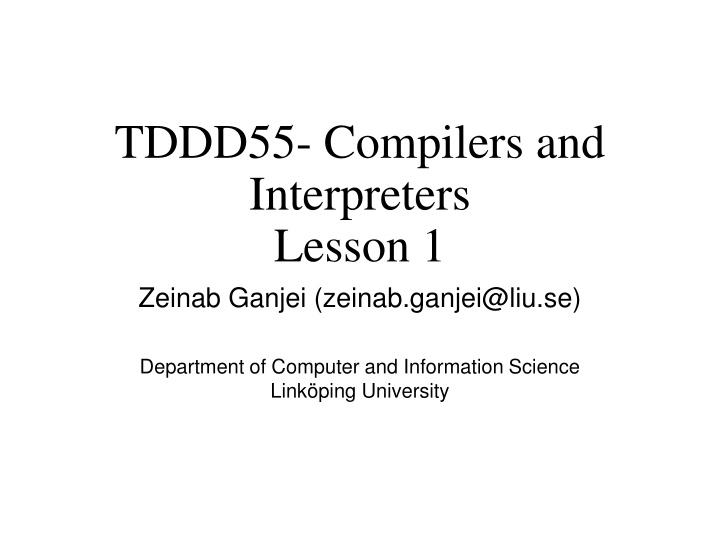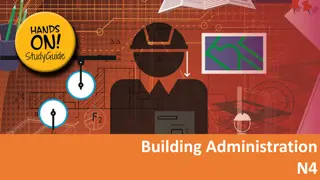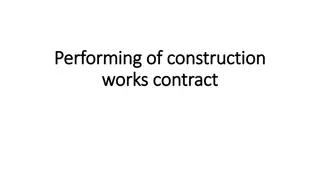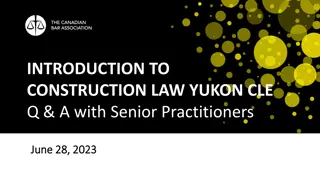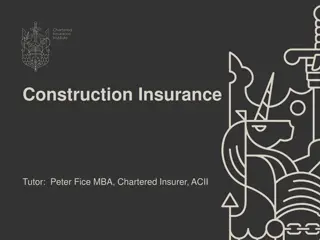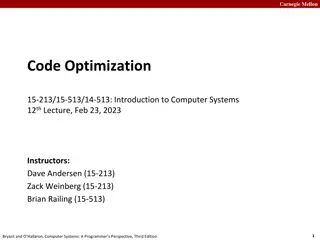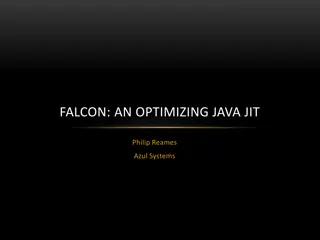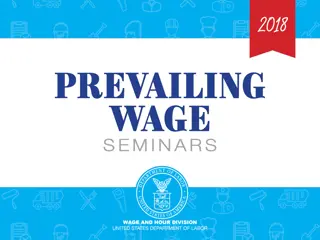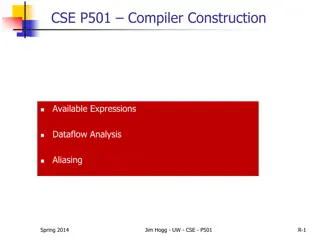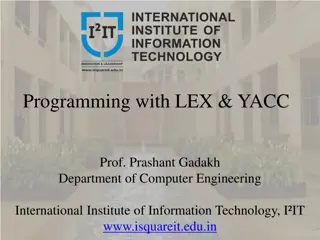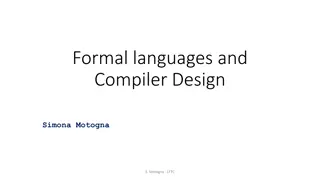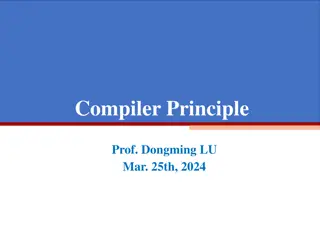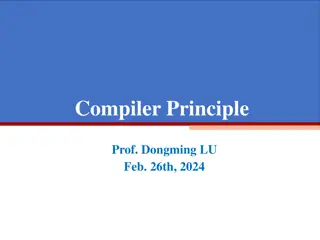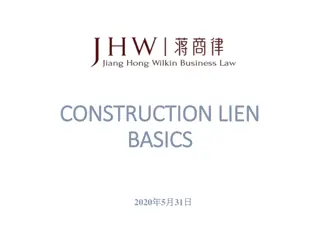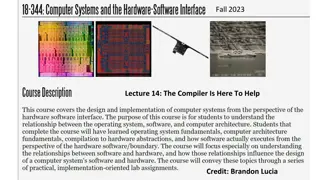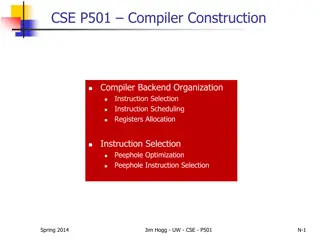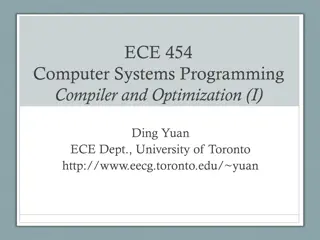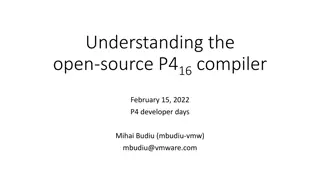Compiler Construction Essentials
In this course on compilers and interpreters, you will delve into theory, practice, and assignments focused on formal languages, automata, scanner specification, and code generation. Prepare for the final examination by engaging with laboratory exercises covering attribute grammars, parsing, and more. Ensure to meet the deadlines for handing in your completed assignments. The schedule includes sessions on Flex, Bison, and exam readiness. Embrace this opportunity to enhance your skills in compiler construction.
Download Presentation

Please find below an Image/Link to download the presentation.
The content on the website is provided AS IS for your information and personal use only. It may not be sold, licensed, or shared on other websites without obtaining consent from the author.If you encounter any issues during the download, it is possible that the publisher has removed the file from their server.
You are allowed to download the files provided on this website for personal or commercial use, subject to the condition that they are used lawfully. All files are the property of their respective owners.
The content on the website is provided AS IS for your information and personal use only. It may not be sold, licensed, or shared on other websites without obtaining consent from the author.
E N D
Presentation Transcript
TDDD55- Compilers and Interpreters Lesson 1 Zeinab Ganjei (zeinab.ganjei@liu.se) Department of Computer and Information Science Link ping University
Purpose of Lessons Practice theory Introduce the laboratory assignments Prepare for the final examination. Prepare by reading the laboratory instructions, the course book, and the lecture notes. All the laboratory instructions and material available in the course directory, ~TDDD55/lab/ or on the course homepage.
Laboratory Assignments In the laboratory exercises you should get some practical experience in compiler construction. There are 4 separate assignments to complete in 4x2 laboratory hours. You will also (most likely) have to work during non-scheduled time.
Lessons Schedule Formal languages and automata theory Formal languages and automata theory, Flex Intermediate code generation, Bison Exam preparation
Handing in and deadline Demonstrate the working solutions during scheduled sessions. Then, hand in code and answers to any questions via e-mail. One e-mail from your LiU-email per group (subject: TDDD55: lab no. ). Deadline for all the assignments is: December 20 2017. Sign up in the webreg!
Laboratory Assignments Lab 1Attribute Grammars and Top-Down Parsing Lab 2 Scanner Specification Lab 3 Parser Generators Lab 4 Intermediate Code Generation
1. Attribute Grammars and Top-Down Parsing Some grammar rules are given Your task: Rewrite the grammar (eliminate left recursion, etc.) Add attributes and attribute rules to the grammar Implement your attribute grammar in a C++ class named Parser. The Parser class should contain a method named Parse that returns the value of a single statement in the language.
2. Scanner Specification Finish a scanner specification given in Flex(scanner.l), by adding rules for comments, identifiers, integers, and reals. More details in lesson 2.
3. Parser Generators Finish a parser specification given in Bison (parser.y), by adding rules for expressions, conditions and function definitions, .... You also need to augment the grammar with error productions. More details in lesson 3.
4. Intermediate Code Generation The purpose of this assignment to learn about how parse trees can be translated into intermediate code. Finish a generator for intermediate code by adding rules for some language statements. More details in lesson 3
Hints for Laboratory Assignment 1
Grammar for simple mathematical expressions S -> E <end of line> S | <end of file> E -> E + E | E - E | E * E | E / E | E ^ E | - E | ( E ) | id ( E ) | id | num Single expression No more input Addition Subtraction Multiplication Division Exponentiation Unary minus Grouping Function call Symbolic constant Numeric value
Not Suitable for a Top-Down Technique No operator precedence e.g E -> E + E | E * E No operator associativity e.g. E ^ E Left recursion e.g. E -> E + E Ambiguity
Rewriting the Grammar Use one non-terminal for each precedence level. E ::= E + E | E E | T T ::= T * T | T / T (Left) Associativity: using (left-)recursive production E ::= E + E | E E | T => E ::= E + T | E T | T See for instance: http://www.lix.polytechnique.fr/~catuscia/teaching/cg428/02Spring/lectur e_notes/L03.html
Rewriting the Grammar (2) The grammar obtained so far has left recursion Not suitable for a predictive top-down parser Transform the grammar to right recursive form: A ::= A | (where may not be preceded by A) is rewritten to A ::= A A ::= A | See Lecture 5 Syntax Analysis, Parsing More details: http://en.wikipedia.org/wiki/Left_recursion
Attribute Grammars Define attributes for the productions of a formal grammar Example: S ::= E { display( E.val ); } E ::= E + T { E.val = E.val + T.val; } | T { E.val = T.val; } T ::= T * F { T.val = T.val * F.val; } | F { T.val = F.val; } F ::= ( E ) { F.val = E.val; } | num { F.val = num.val; } See course book and Lecture 8 for details. See also: http://en.wikipedia.org/wiki/Attribute_grammar
Implementation: main.cc int main(void) { Parser parser; double val; while (1) { try { cout << "Expression: " << flush; val = parser.Parse(); cout << "Result: " << val << '\n' << flush; } catch (ScannerError& e) { cerr << e << '\n' << flush; parser.Recover(); } catch (ParserError) { parser.Recover(); } } catch (ParserEndOfFile) { cerr << "End of file\n" << flush; exit(0); } } }
Implementation: lex.cc and lex.hh The files lex.cc and lex.hh implement the lexer You don t need to change anything in those files.
Implementation : lab1.cc, lab1.hh double Parser::Parse(void) { Trace x( Parse ); double val = 0; current_token = scanner.Scan(); switch (current_token.type) { case kIdentifier: case kNumber: case kLeftParen: case kMinus: val = -1*pExpression(); if (current_token.type != kEndOfLine) throw ParserError(); default: throw ParserError(); } return val; }
Implementation Add one function for each non-terminal in the grammar to your Parser class. Also implement some simple error recovery in your Parser class. See Lecture 5 for details. double Parser::pExpression(void) { switch (current_token.type) { ... } }
Laboratory skeleton ~TDDD55 /lab /doc Documentation for the assignments. /lab1 Contains all the necessary files to complete the first assignment /lab2 Contains all the necessary files to complete the second assignment /lab3-4 Contains all the necessary files to complete assignment three and four
Installation Take the following steps in order to install the lab skeleton on your system: Copy the source files from the course directory onto your local account: mkdir TDDD55 cp -r ~TDDD55/lab TDDD55 You might also have to load some modules (more information in the laboratory instructions).
